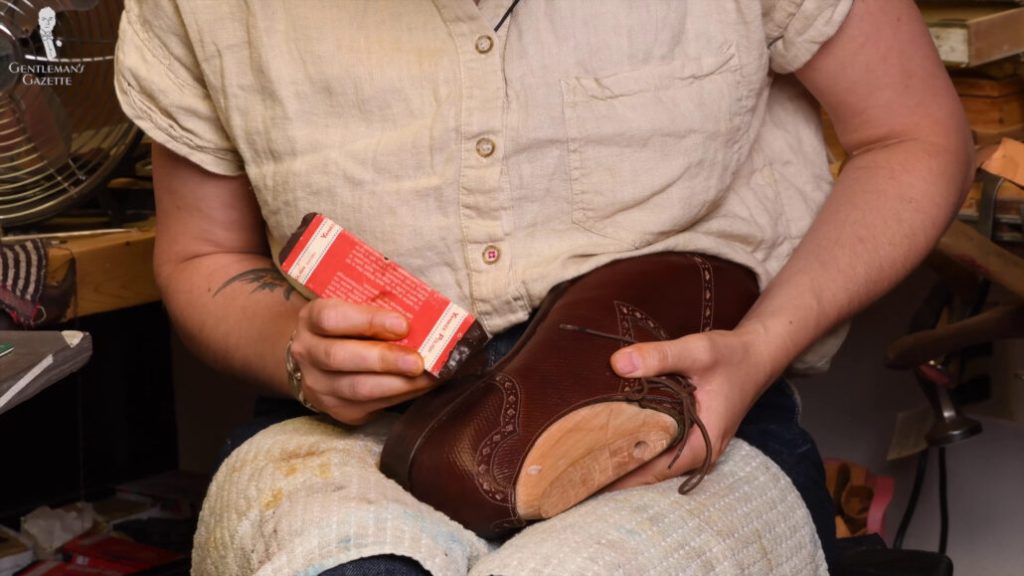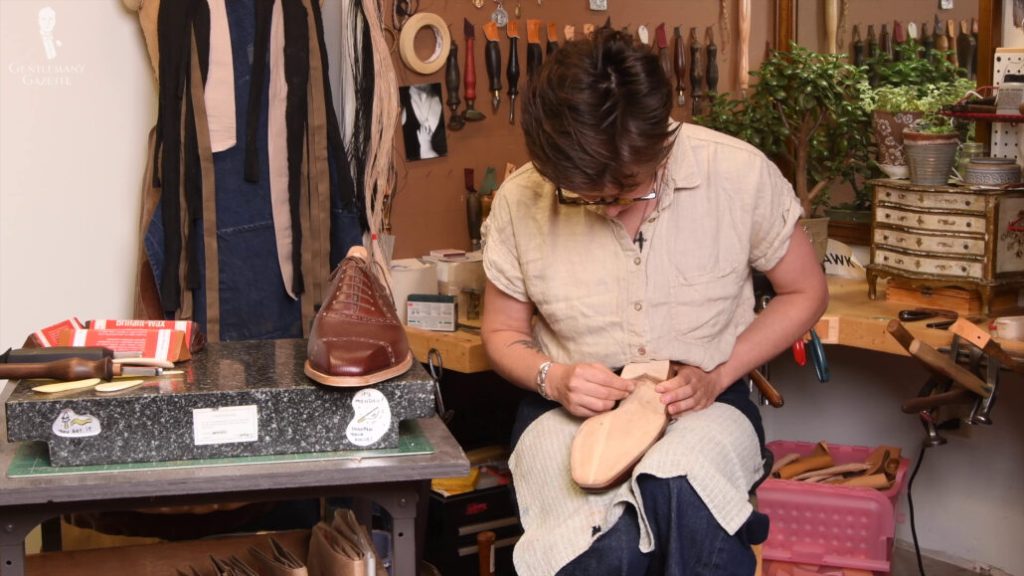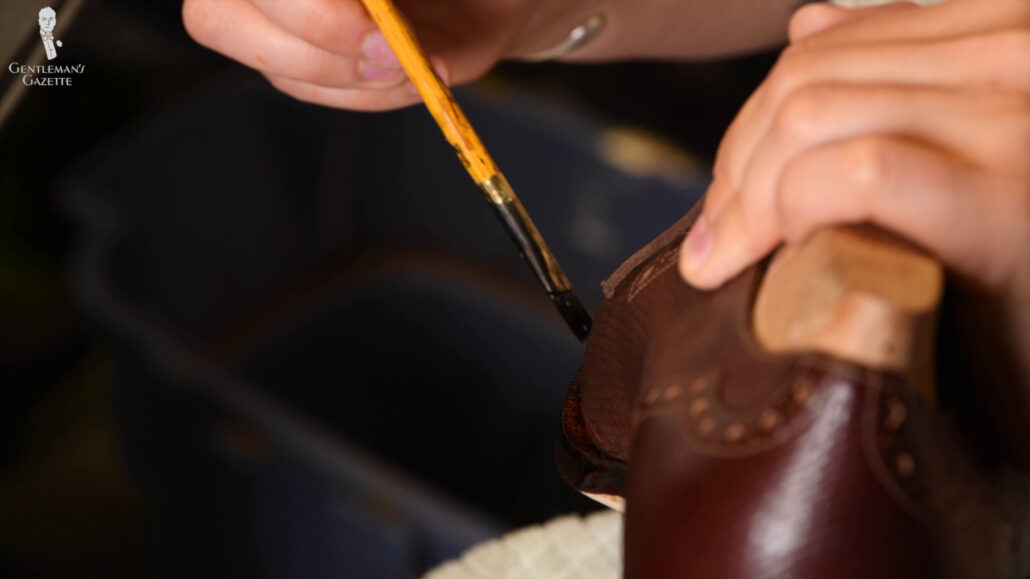In the world of shoe making, there is a crucial step that often goes unnoticed, yet plays a significant role in creating a truly unique pair of bespoke shoes. The finishing touches of shoe heels, soles, and bottoms are what give them their distinctive character. From initial smoothing and glassing to dyeing and waxing, each step is carefully executed to open up the fibers, enhance color, and add a glossy shine. Decorative nails and multiple layers of wax are applied to not only protect the shoe but also provide visual depth. This article sheds light on the meticulous attention to detail and craftsmanship involved in the finishing process, emphasizing its importance in creating one-of-a-kind bespoke shoes.

I. Smoothing and Glassing the Leather
In order to create the perfect finish for bespoke shoe heels, soles, and bottoms, the first step is to smooth and glass the leather. This process involves opening up the fibers of the leather and creating a smooth surface.
A. Opening up the fibers
Opening up the fibers of the leather is an essential step in the finishing process. By using specialized tools, the leather is gently manipulated to loosen the tightly woven fibers. This not only helps to create a more supple and flexible leather, but also prepares it for the next steps in the finishing process.
B. Creating a smooth surface
Once the fibers of the leather have been opened up, the next step is to create a smooth surface. This involves carefully sanding and buffing the leather to remove any imperfections and create an even and polished look. The aim is to create a surface that is not only visually appealing but also smooth to the touch.
II. Dyeing the Sides of the Shoe
Dyeing the sides of the shoe is a crucial step in the finishing process as it adds color and depth to the final product. It is important to use an alcohol-based pigment dye for this step, as it ensures strong adherence and longevity.
A. Importance of using alcohol-based pigment dye
Alcohol-based pigment dye is preferred for dyeing the sides of the shoe because it offers better absorption and adherence to the leather. Unlike water-based dyes, alcohol-based pigments penetrate the leather more effectively, resulting in a richer and more vibrant color.
B. Ensuring strong adherence
To ensure strong adherence of the dye to the leather, the sides of the shoe must be properly prepared. This involves thoroughly cleaning and degreasing the leather to remove any residual substances that may hinder the dye from properly adhering. Additionally, applying the dye in thin and even layers will help to achieve a uniform color and prevent any drips or streaks.
C. Quick drying process
After the dye has been applied, it is important to allow it to dry quickly. This can be achieved by using a heat source such as a heat gun or hairdryer. Quick drying is essential to prevent any bleeding or smudging of the dye and ensures a clean and polished finish.
III. Nailing for Structural Integrity
Nailing is an important step in the finishing process of bespoke shoes as it provides structural integrity and durability. It is crucial to nail after dyeing to avoid cracking the wax layer that will be applied later on. Additionally, different types of decorative nails can be used to add aesthetic value to the finished product.
A. Importance of nailing after dyeing
Nailing after dyeing is essential because the dye tends to darken and harden the leather. By nailing after the dyeing process, the nails can properly penetrate the leather and ensure a secure hold. This step helps to reinforce the structural integrity of the shoe and prevent any loosening or separation of the materials over time.
B. Avoiding cracking of wax layer
Nailing before applying the wax layer can result in cracking and compromising the integrity of the finish. The nails may create pressure points that could cause the wax to crack or flake off. By nailing after dyeing, the wax layer can be applied smoothly and evenly, without any risk of compromising the final appearance.
C. Different types of decorative nails for aesthetic value
During the nailing process, there is an opportunity to add aesthetic value to the finished product. Different types of decorative nails can be used to enhance the design and overall appearance of the shoe. Whether it is a simple pattern or intricate detailing, the choice of decorative nails allows for personalization and customization, making each pair of bespoke shoes truly unique.
IV. Waxing for Color, Shine, and Reflection
Waxing is an essential step in the finishing process as it enhances the color, shine, and reflection of the bespoke shoes. Selecting the right wax and applying it correctly are crucial to achieving the desired results.
A. Selecting the right wax
Choosing the right wax is important as it determines the final appearance and protection of the shoes. Beeswax, carnauba wax, and synthetic wax are commonly used in the finishing process. Beeswax provides a natural and soft sheen, while carnauba wax offers a high-gloss finish. Synthetic waxes provide durability and protection.
B. Applying wax with a hammer-shaped iron
Applying wax is a meticulous process that requires attention to detail. A hammer-shaped iron is used to evenly distribute the wax onto the leather. This tool ensures that the wax is applied in thin, even layers, allowing for better absorption and reducing the risk of clumping or streaking.
C. Importance of different types of wax
Different types of wax can be used to achieve certain effects and finishes. For example, if a deep, lustrous shine is desired, a higher concentration of carnauba wax can be used. On the other hand, if a matte finish is preferred, a matte or satin wax can be applied. The choice of wax depends on the desired outcome and the preferences of the client.
D. Multiple layers for protection and visual depth
To achieve maximum protection and visual depth, multiple layers of wax are applied. Each layer is carefully buffed and polished before the next layer is added. This process allows for a build-up of wax, resulting in a more durable and visually stunning finish. The multiple layers also contribute to the depth and richness of the color, enhancing the overall appearance of the shoes.

V. Touch-ups and Minor Corrections
After the waxing process, it is important to inspect the shoes for any imperfections or areas that may require touch-ups. Using dye and a fine brush, minor corrections can be made to ensure a flawless finish.
A. Using dye for touch-ups
If there are any areas where the dye may have faded or where the leather did not fully absorb the color, dye can be used for touch-ups. By carefully applying a small amount of dye with a fine brush, these areas can be brought back to match the rest of the shoe, creating a seamless finish.
B. Utilizing a fine brush for precision
A fine brush is an invaluable tool for precision work during the touch-up process. Whether it is correcting minor imperfections or adding subtle accents, a fine brush allows for meticulous detail work. This attention to detail ensures that every aspect of the shoe is perfected, leaving no room for flaws or inconsistencies.
VI. Attention to Detail and Craftsmanship
Throughout the finishing process of bespoke shoes, attention to detail and craftsmanship are of utmost importance. The finishing touches play a significant role in creating shoes that are truly unique and of the highest quality.
A. Importance of attention to detail
Attention to detail is essential to create a flawless finish on bespoke shoes. Whether it is ensuring that every seam is properly polished or that the color gradient is consistent, every aspect must be meticulously attended to. It is these small details that elevate the shoes from ordinary to extraordinary, making them truly remarkable and worthy of being called bespoke.
B. Showcasing the craftsmanship involved in the finishing process
The finishing process of bespoke shoes showcases the immense craftsmanship and skill of the shoemaker. From the careful selection of materials to the precise application of dyes, waxes, and finishes, every step requires a mastery of technique and an understanding of the desired outcome. The finishing touches are the culmination of a labor-intensive process, where the artistry and dedication of the shoemaker are brought to life in the final product.

VII. Final Polishing and Buffing
The final step in the finishing process is polishing and buffing to achieve a smooth and glossy finish. This step enhances the overall appearance of the shoes and ensures that they are ready for display or delivery.
A. Achieving a smooth and glossy finish
Polishing and buffing are essential to achieve a smooth and glossy finish on the shoes. Using specialized products and techniques, the surface of the leather is gently buffed to remove any residual wax or polish, resulting in a pristine and polished appearance. This final step brings out the natural luster of the leather and enhances the overall shine and brilliance of the shoes.
B. Enhancing the overall appearance of the shoes
The final polishing and buffing step is not just about achieving a smooth and glossy finish, but also about enhancing the overall appearance of the shoes. It is during this step that any remaining imperfections or inconsistencies are addressed, creating a uniform and flawless surface. The attention to detail and craftsmanship exhibited in this final step further elevates the shoes and ensures that they are truly exceptional in every aspect.
VIII. Quality Control
Quality control is vital in the finishing process to ensure that the finished shoes meet the highest standards of craftsmanship and durability. Inspecting the finished shoes for any flaws or imperfections is a crucial step in this process.
A. Inspecting the finished shoes for any flaws
When the finishing process is complete, the shoes are carefully inspected for any flaws or imperfections. This includes checking for any uneven dyeing, loose stitches, or damage to the leather. Any necessary touch-ups or corrections can be made at this stage to ensure that the final product is flawless and of the highest quality.
B. Ensuring high standards are met
High standards are a hallmark of bespoke shoes, and the finishing process is no exception. It is imperative to adhere to strict quality control measures to ensure that the finished shoes meet and exceed the expectations of the client. This includes not only scrutinizing every detail of the shoes but also adhering to ethical and sustainable practices throughout the production process. By maintaining high standards, shoemakers can continue to deliver exceptional and unique bespoke shoes that bring joy and satisfaction to their clients.

IX. Packaging and Presentation
The packaging and presentation of bespoke shoes are integral to providing a complete and satisfying experience for the client. The way the shoes are packaged and presented can enhance their perceived value and create a lasting impression.
A. Preparing the bespoke shoes for delivery or display
Before the shoes are delivered to the client or displayed in a retail setting, they need to be carefully prepared. This involves wrapping them in protective materials to ensure they arrive in perfect condition. Additionally, any branding or personalized elements can be added to the packaging to create a sense of exclusivity and luxury.
B. Creating an appealing packaging and presentation
Creating an appealing packaging and presentation is vital to create a memorable experience for the client. This can be achieved through the use of high-quality materials, elegant design elements, and attention to detail. From the placement of the shoes within the packaging to the inclusion of any additional accessories or care instructions, every aspect contributes to the overall presentation and showcases the level of care and craftsmanship that has gone into creating the shoes.
X. Client Satisfaction and Unique Bespoke Shoes
The finishing touches play a crucial role in creating unique bespoke shoes that exceed the expectations of the client. By paying close attention to the details, shoemakers can enhance client satisfaction and ensure that they receive a truly exceptional product.
A. Importance of finishing in creating unique bespoke shoes
The finishing process is what truly distinguishes bespoke shoes from mass-produced footwear. It is in the finishing touches that the personality and character of the shoes are revealed. By carefully considering each step and taking the time to perfect every detail, shoemakers can create shoes that are truly unique and reflect the individuality of the client.
B. Enhancing client satisfaction with attention to finishing details
An impeccably finished pair of shoes not only demonstrates the skill and craftsmanship of the shoemaker but also enhances client satisfaction. Attention to finishing details shows that the shoemaker has taken the time and effort to create a product that is of the highest quality and meets the specific requirements and desires of the client. This commitment to excellence contributes to a truly satisfying experience for the client and ensures that they will enjoy their bespoke shoes for years to come.

